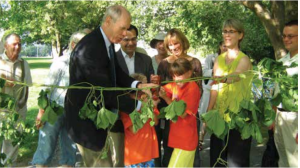John Dance

Photo by John Dance
In 2009, the rebuilt trail between Springhurst Park and the transitway was officially opened.
Who knew that Old Ottawa East has one of the best hiking trails in the Ottawa area?
The Rideau River Nature Trail is flatteringly described as such in Michael Haynes’ new book, Hiking Trails of Ottawa, the National Capital Region, and Beyond.
“I must confess that I discovered it by accident, deciding to explore that bank of the river,” says Haynes. “But after I walked it, I knew that I had to include it; it’s wonderful and feels as if it is a hidden reserve surrounded by and preserved from the busy urban core.”
The trail, which runs from the Highway 417 bridge to Old Ottawa South, was one of the original projects of Sustainable Living Ottawa East (SLOE). SLOE worked with the City of Ottawa, the Rideau Valley Conservation Authority and a variety of other parties to make the trail a walker’s delight.
The route had long been slated to be integrated into the City’s Rideau River Western Pathway, but SLOE seized the initiative to ensure that the route was both as ecologically healthy and as pedestrian friendly as possible.
The consequence is most evident along the Greystone Village river frontage where a separate footpath wanders through the meadow-like area, and behind Rideau Garden Drive where the pathway remains unpaved.
But all along that portion of the RRNT within Old Ottawa East, a naturalized buffer zone helps protect the river from erosion and contributes to the shoreline and aquatic habitat.
The RRNT is one of 50 trails lovingly described in Haynes’ book. Others include many notable Gatineau Park routes and Murphy’s Point.
The description of RRNT shows that the total ascent/descent over the 2.9 kilometre trail is just five metres, which makes it one of the easiest hikes described in the book.
When SLOE originally conceived the route there were numerous challenges.
First, there was no easy way to get up the hill from Brantwood Park to the Oblates lands (now Greystone Village). Second, the pathway behind the Lees Avenue apartment buildings was very rough. Third, there was no accessible way to get from the trail into the property behind the Lees campus of the University of Ottawa.
By taking advantage of other projects such as LRT and sewer replacement work, SLOE was able to convince the City of Ottawa and other parties to make necessary improvements. One of the biggest challenges was to persuade the University of Ottawa to allow the pathway to run along the shoreline of the Lees campus.
The university wanted to detour the trail so they could build their new stadium but, after pushback from the community association, a turf sports field was built with “chamfered” corners so that there would be enough space for the trail to get around it and run along the river.
In addition to the infrastructure improvements, SLOE members implemented a set of plaques along the route, outlining key historical facts and natural features. Also, extensive tree planting was done, an effort that continues.
The trail continues to get lots of attention from the community. SLOE’s “Invasives Brigade” continues with its Sisyphean task of removing invasives. Trees must be planted to replace the dead ash. And there is an ongoing discussion of how to deal with the pandemic-driven trail-widening behind Rideau Garden Drive.
A unique aspect of the trail is how much of it is a snapping turtle nesting habitat, “…a pretty special feature for an urban trail,” says Mary Trudeau, one of the initial proponents of the trail.
Michael Haynes is one of the leading authorities on trail development in Canada. He has been named a trail hero by Hike Ontario and has authored nine trail guides. He is now a resident of Nova Scotia and is preparing a new book on hiking trails of Prince Edward Island.
Hiking Trails of Ottawa is available at Singing Pebble Books on Main Street.






